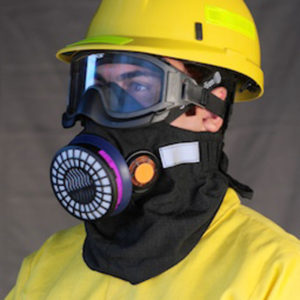By: Robert Avsec, Executive Fire Officer
No longer can fire departments and the communities they serve provide their firefighters with only the structural firefighting ensemble,

Fire departments should consider providing PPE options for their personnel that provide a better balance between protection and comfort when they respond to non-structural firefighting calls for service.
aka, turnout gear, as their only personal protective equipment option. That ensemble is designed and manufactured to protect a firefighter from the physical and thermal hazards associated with interior structural firefighting. Period.
Now, this is not new information by any means. But it has taken on another level of relevance as we seek to reduce the exposure of firefighters to the toxic chemicals, chemical compounds, and carcinogens present in structure fire smoke. It’s time to limit wearing of firefighting turnout gear to structure fires.
Other PPE options for all firefighters
Firefighters need to have PPE options that more closely align with the tactical operations that they do beside just structural firefighting. No longer can structural PPE be the “one size fits all” option.
See Non-structural firefighter PPE: From EMS calls to wildland firefighting, today’s firefighters face more than just structural interior firefighting
I’m sure the first reaction—among others—is going to be “We can’t afford it!” I say you can’t afford not to. Just look at the rising numbers of firefighters developing cancer and dying from cancer. If you didn’t click on the link above, here it is again.
So, without further ado, here are the different PPE options that every firefighter should have available to them, based of course on the types of calls that they respond to on a routine basis.
| Package A: PPE for non-structure fire responses | Estimated Cost |
| Heavy-duty waterproof gloves for handling wet hose and equipment for bagging after its undergone gross decontamination. | $5.00–$10.00/pair |
| Fire-resistant and cut-resistant coveralls (e.g., Kevlar/Nomex blend) to wear over station uniform or civilian clothes when working at non-structure fire calls (e.g., EMS calls, motor vehicle crashes, grass and brush fires). | $385.00/item |
| Heavy-duty work jacket (e.g., a high-visibility 3-season jacket) to wear when operating in adverse weather (e.g., cold, precipitation) at EMS calls, motor vehicle crashes, and other types of incidents deemed appropriate by one’s department. | $200.00/item |
| Cotton coveralls to wear at the fire station after showering and before they start working to clean equipment, restock supplies, etc., after a structure fire call. | $30.00–$50.00/item |
| TOTAL | $620.00–$645.00/item |
If your department responds to wildland fires
And this includes fires in the wildland urban interface as well. Your firefighters need PPE that matches the tasks they carry out when suppressing such fires.
| Package B: PPE for wildland and WUI firefighting | Estimated Cost |
| Wildland firefighting helmet (e.g., full brim or cap style). | $30-$75/item |
| Face and neck protection. And that includes measures to minimize the breathing of smoke. As we saw in last year’s devastating wildfires in California, when what’s on fire is more than just the woods firefighters are exposed to “who knows what.” And even breathing smoke from burning natural fuels is not healthy. | $95.00/item |
| TOTAL | $125.00–$180.00 |
See Related: Structural firefighters need wildland firefighting PPE, too
Now my quick math calculations show that for Packages A and B a fire department would be spending approximately $825/per firefighter which is substantially less than the $2500 or more for the cost of a structural firefighting ensemble.
But in reality, it’s a “win-win-win” for firefighters and their departments. Firefighters would be getting PPE options more suited to the work they’re doing and they’d be spending less time in their structural PPE (And in turn, having less exposure to residual toxic materials that can be present even after laundering).
Fire department leaders would see less wear and tear on structural PPE, meaning longer lifecycles for that gear. Yes, some of those other PPE items in Packages A and B might need to be replaced more often (e.g. extrication coveralls) but at a much lower cost (A real positive when one considers the potential for getting body fluids or gasoline or oil on structural turnout gear that in turn can’t be properly decontaminated).
PPE that should be on fire apparatus
The following items don’t need to be assigned to individuals but must be readily available for personnel to use when the need arises.
| Package C: PPE items for fire apparatus | Estimated Cost |
| Full-face shields (Like those used in medical labs) for use when conducting gross decontamination of their fellow firefighters on the fireground. Also, back at the fire station when working to clean and decontaminate PPE and other equipment. | $15–$25/item |
| Tyvek coveralls or PVC rain suits for use when conducting gross decontamination of their fellow firefighters on the fireground. | $50.00 (Tyvek)/item
$50.00 PVC suit/item |
| TOTAL | $65.00–$75.00 |
The total number of the items needed in Package C will obviously be dependent upon the size of the fire department, number of apparatus, and potential for usage on the emergency scene.

Colon cancer is just one of the types of cancer that affect firefighters in greater numbers than the public. Talk with your health care provider about the appropriate medical surveillance for you and your colon.
 Fire & EMS Leader Pro The job of old firefighters is to teach young firefighters how to become old firefighters!
Fire & EMS Leader Pro The job of old firefighters is to teach young firefighters how to become old firefighters!